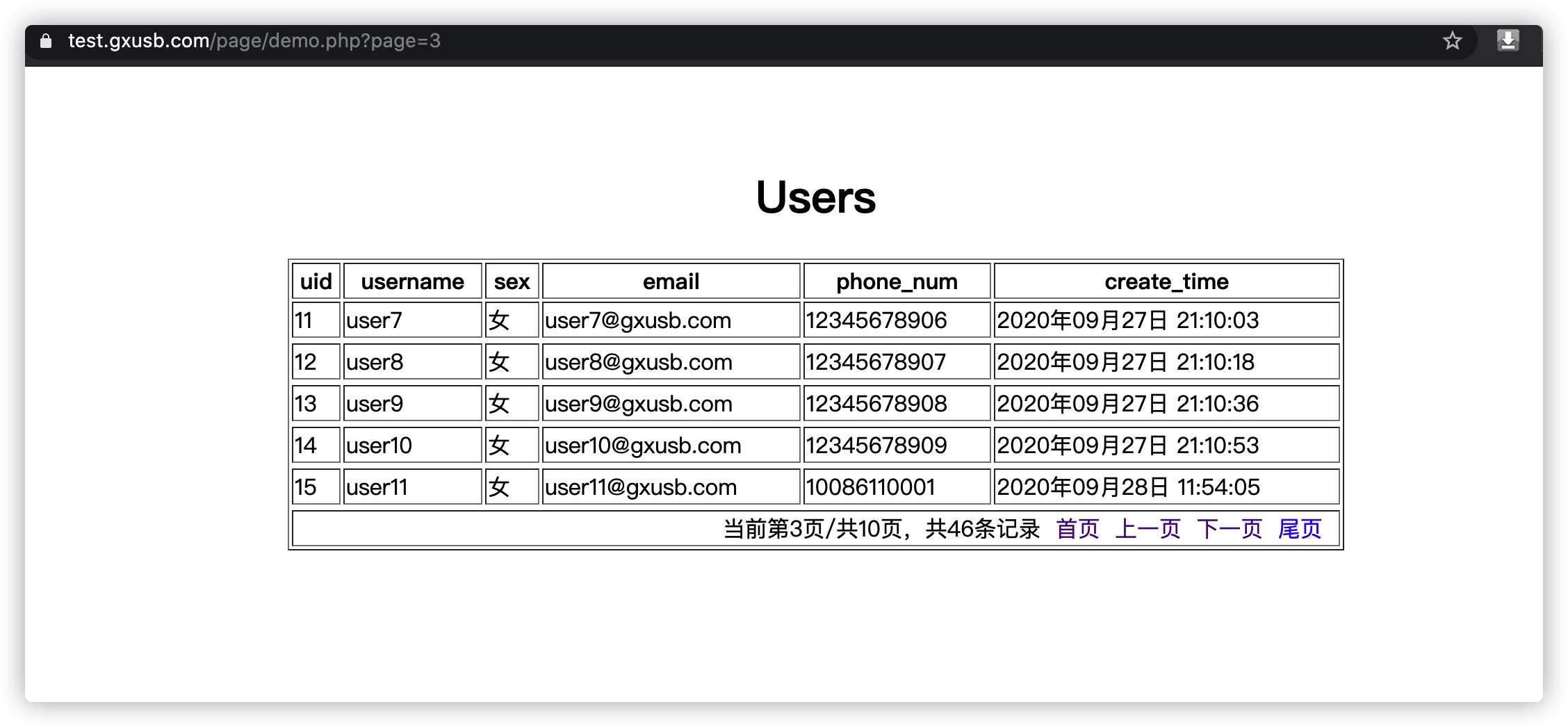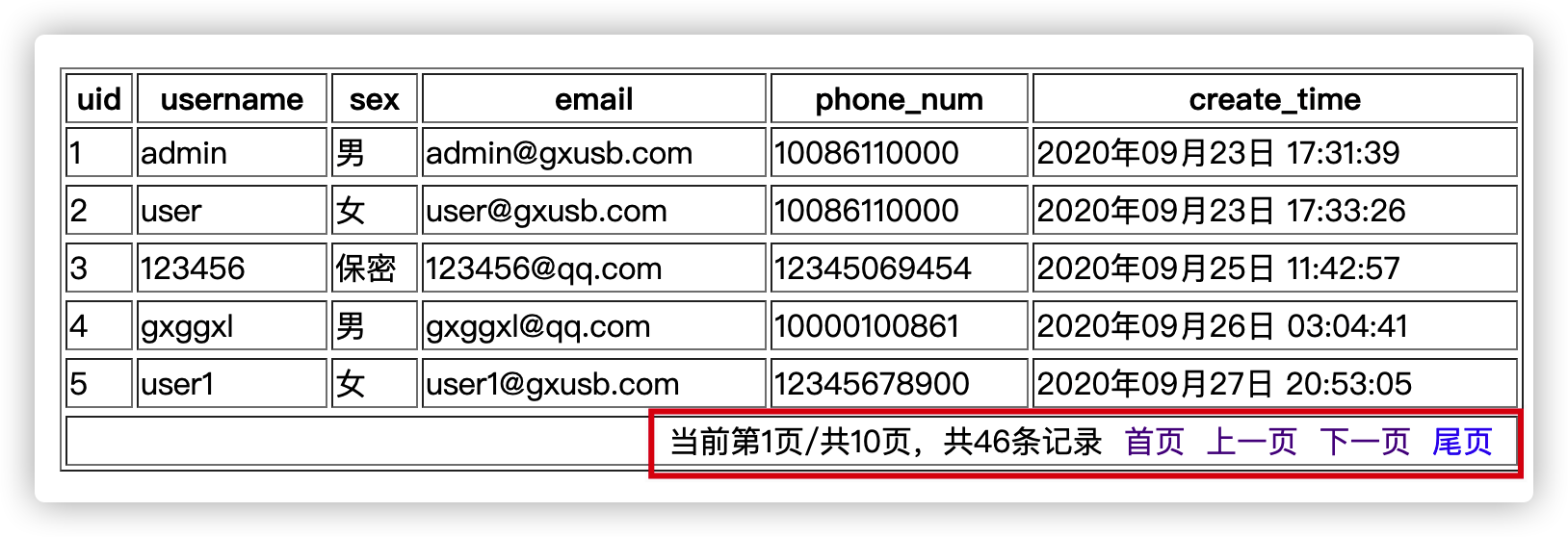PHP 分页类
一个原生的PHP分页类(PHP pagination class)。
分页类代码
<?php
/**
* @author :gxggxl
* @BlogURL : https://gxusb.com
* @DateTime : 2020/10/10 16:33
* page.class.php
*/
class Page
{
//成员属性
private $page;//当前页
private $maxRows;//总条数
private $pageSize;//每页显示多少条
private $maxPage = 0;//总页数
private $url;//当前页面的URL地址
private $urlParam = '';//当前页面的参数
//成员方法
public function __construct($maxRows, $pageSize = 5) {
//进行初始化赋值操作
$this->maxRows = $maxRows;
$this->pageSize = $pageSize;
//定义当前页
$this->page = isset($_GET['page']) ? $_GET['page'] : 1;
//获取当前页面的URL地址
$this->url = $_SERVER['PHP_SELF'];
//获取总页数
$this->getMaxPage();
//验证当前页的值
$this->checkPage();
//调用URL参数
$this->urlParam();
}
// getMaxPage 计算总页数
private function getMaxPage() {
//判断除数
if ($this->pageSize < 1) {
$this->pageSize = 1;
}
$this->maxPage = @ceil($this->maxRows/$this->pageSize);
}
//验证当前页
private function checkPage() {
if ($this->page > $this->maxPage) {
$this->page = $this->maxPage;
}
if ($this->page < 1) {
$this->page = 1;
}
if ($this->pageSize > $this->maxRows) {
$this->pageSize = $this->maxRows;
}
if ($this->pageSize < 1) {
$this->pageSize = 1;
}
}
//过滤当前URL地址中的参数信息
private function urlParam() {
foreach ($_GET as $key => $value) {
//判断参数值和参数名是否有效
if ($value != '' && $key != 'page') {
$this->urlParam .= '&' . $key . '=' . $value;
}
}
// echo $this->urlParam;
}
/**
* 输出页码
*
* @return string
*/
public function showPage() {
$str = '';
$str .= '当前第' . $this->page . '页/共' . $this->maxPage . '页,共' . $this->maxRows . '条记录 ';
$str .= '<a href="' . $this->url . '?page=1' . $this->urlParam . '">首页</a> ';
$str .= '<a href="' . $this->url . '?page=' . ($this->page - 1) . $this->urlParam . '">上一页</a> ';
$str .= '<a href="' . $this->url . '?page=' . ($this->page + 1) . $this->urlParam . '">下一页</a> ';
$str .= '<a href="' . $this->url . '?page=' . $this->maxPage . $this->urlParam . '">尾页</a> ';
return $str;
}
/**
* 返回分页的limit条件
*
* @return string
*/
public function limit() {
$num = ($this->page - 1)*$this->pageSize;
return $num . ',' . $this->pageSize;
}
}
分页类使用方法
//引入分页类
include "page.class.php";
header("Content-Type:text/html;charset=utf-8");
//数据库连接资源
$link = mysqli_connect("127.0.0.1", "test", "123456", "test");
//得到结果集
$result = mysqli_query($link, "select * from crm_users");
//获取记录总条数
$total = mysqli_num_rows($result);
//设计每页显示条数
$pageSize = isset($_GET['size']) ? $_GET['size'] : 5;
//实例化分页类,$total(总条数),$pageSize(每页显示条数)
$page = new Page($total, $pageSize);
//拿到分页查询条件
$limit = $page->limit();
//sql语句
$sql = "select * from crm_users limit {$limit}";
//查询数据
$result = mysqli_query($link, $sql);
//把结果在表格中显示
echo '<style>a{text-decoration: none;}</style>';
echo '<table border="1" style="width: 760px;margin: 50px auto;">';
echo '<caption><h1>Users</h1></caption>';
echo '<tr><th>uid</th><th>username</th><th>sex</th><th>email</th><th>phone_num</th><th>create_time</th></tr>';
//从结果集中取得一行作为关联数组
while ($row = mysqli_fetch_assoc($result)) {
echo '<tr>';
echo '<td>' . $row["uid"] . '</td>';
echo '<td>' . $row["username"] . '</td>';
echo '<td>' . $row["sex"] . '</td>';
echo '<td>' . $row["email"] . '</td>';
echo '<td>' . $row["phone_num"] . '</td>';
echo '<td>' . date('Y年m月d日 H:i:s', $row["create_time"]) . '</td>';
echo '<tr>';
}
echo '<tr><td colspan="6" style="text-align: right">' . $page->showPage() . '</td></tr>';
echo '</table>';- 分页类效果

- 演示地址
拓展
另一种设置 url 地址的方法
protected function getUrl(){ //获取文件地址 $path=$_SERVER['SCRIPT_NAME']; //获取主机名 $host=$_SERVER['HTTP_HOST']; //获取端口号 $port=$_SERVER['SERVER_PORT']; //获取协议 $scheme=$_SERVER['REQUEST_SCHEME']; //获取参数 $queryString=$_SERVER['QUERY_STRING']; if (strlen($queryString)) { //解析字符串返回数组 parse_str($queryString,$array); unset($array['page']); $path=$path.'?'.http_build_query($array); } //拼接url地址 $url=$scheme.'://'.$host.':'.$port.$path; //echo $url; //https://test.gxusb.com:443/page/demo.php?size=7&jsj=a return $url; } //设置url 地址 protected function setUrl($page){ if (strstr($this->url,'?') ){ return $this->url.'&page='.$page; }else{ return $this->url.'?page='.$page; } }

